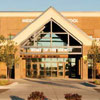
A Gem Of A System
State-of-the-art system brings campus into focus
- By Del V. Salvi
- Nov 01, 2012
Middleton High School, a new 253,905-squarefoot
facility, opened in Middleton, Idaho, in
August 2011, featuring the newest technology
throughout its entire campus, from lighting
and computer-controlled heating and air conditioning
systems to wireless communications
technology.
The newly built school includes a three-story building and a separate
vocational facility with workshops and additional enhanced classrooms—
all of which incorporate innovative features, such as the
prominent use of skylights to flood the common areas and other parts
of the building with natural light and to lower energy usage.
Security was a key part of planning the facility. Video surveillance at
the school involves a system of 112 cameras from Samsung Techwin
America that provide views of every part of the campus. The high
school uses the video for crime prevention, general security and investigation
of incidents. Video views of various parts of the school also are
used in emergency situations and for planning by first responders.
“The staff and student body were all made aware of the importance
of the new camera system during the build-up to the opening of the
new school,” said Middleton Superintendent Richard H. Bauscher.
“The value of the camera system as a tool for crime prevention is undeniable.
We simply would not be able to monitor the campus and solve
many crimes or policy violations without it.”
The video system uses a much larger number of cameras than the
system at the old high school, which has been converted into a middle
school.
The cameras are used throughout the new school to address a variety
of security needs. In the student parking area, for example, three megapixel
cameras combine large-area coverage with system versatility.
Real-Time Video Views
When designing the video system for Middleton, the district wanted
to make it possible for emergency responders to review video of
various parts of the school over the Internet. Previously, they were
able to review photographs of various rooms and the school layout
as an aid to emergency response. The new fixed, PTZ and megapixel
network cameras offer the improvement of providing real
time, direct access to video views of the building and surrounding
grounds, which will enable better response times and planning for
emergency operations.
The vast expansion of the new system, compared to the old system,
provides school officials with a greater variety of camera views.
Overall coverage is enhanced and clearer. The old system used only
11 PTZ cameras outside and 20 fixed mini-domes inside. For the
high school, the district added more cameras to cover the large area,
including several outbuildings.
Middleton administrators chose Samsung cameras and equipment
for the new high school because they provide efficiency and overall
value. The school district also relied on the recommendation of CS
Consulting Corp., the district’s consulting company. The system at
the high school was co-designed by Clarence Weiting of CS Consulting
Corp.; Deputy Kelley Anderson, the school resource officer; and
Middleton High School Assistant Principal Spencer Rickart.
A Solid Investment in Security
The 112 cameras break down to 97 fixed cameras, 12 PTZ cameras
and three megapixel cameras.
The network fixed-dome cameras with true day/night functionality
provide excellent images in low-light conditions and include
highlight compensation to offset bright light sources. The unit’s
weatherproof (IP66-rated), die-cast, vandal-resistant body and
tough polycarbonate bubble stand up to weather extremes.
The Samsung PTZ network cameras are equipped with a 30X
optical zoom and 8X digital zoom, as well as a high-performance
megapixel network camera, including a 1.3-megapixel progressive
CCD sensor that delivers a maximum of 1280x960 highresolution
images.
The Samsung Net-i Viewer is used for monitoring and accessing
camera views during playback. A single PC can monitor up to 32
channels simultaneously in real-time, and the software supports
various search and playback options. Two 64-channel network
video recorders are used for recording and taking still shots. The
high-quality, high-performance network video recorders provide
seamless interoperability with the cameras and viewer software.
Each NVR has 2 terabytes of storage. The system is viewed locally
and through the Internet using iPOLiS software.
On the Job
Just a couple of months after Middleton High opened, the cameras
had already been used as an investigative tool to resolve several
incidents. To date, there have been three traffic accidents in
the parking lot and numerous incidents involving students in the
hallways. Additionally, the school has had six different cases of
theft or vandalism, and the cameras were used each time in the
investigation.
This article originally appeared in the November 2012 issue of Security Today.